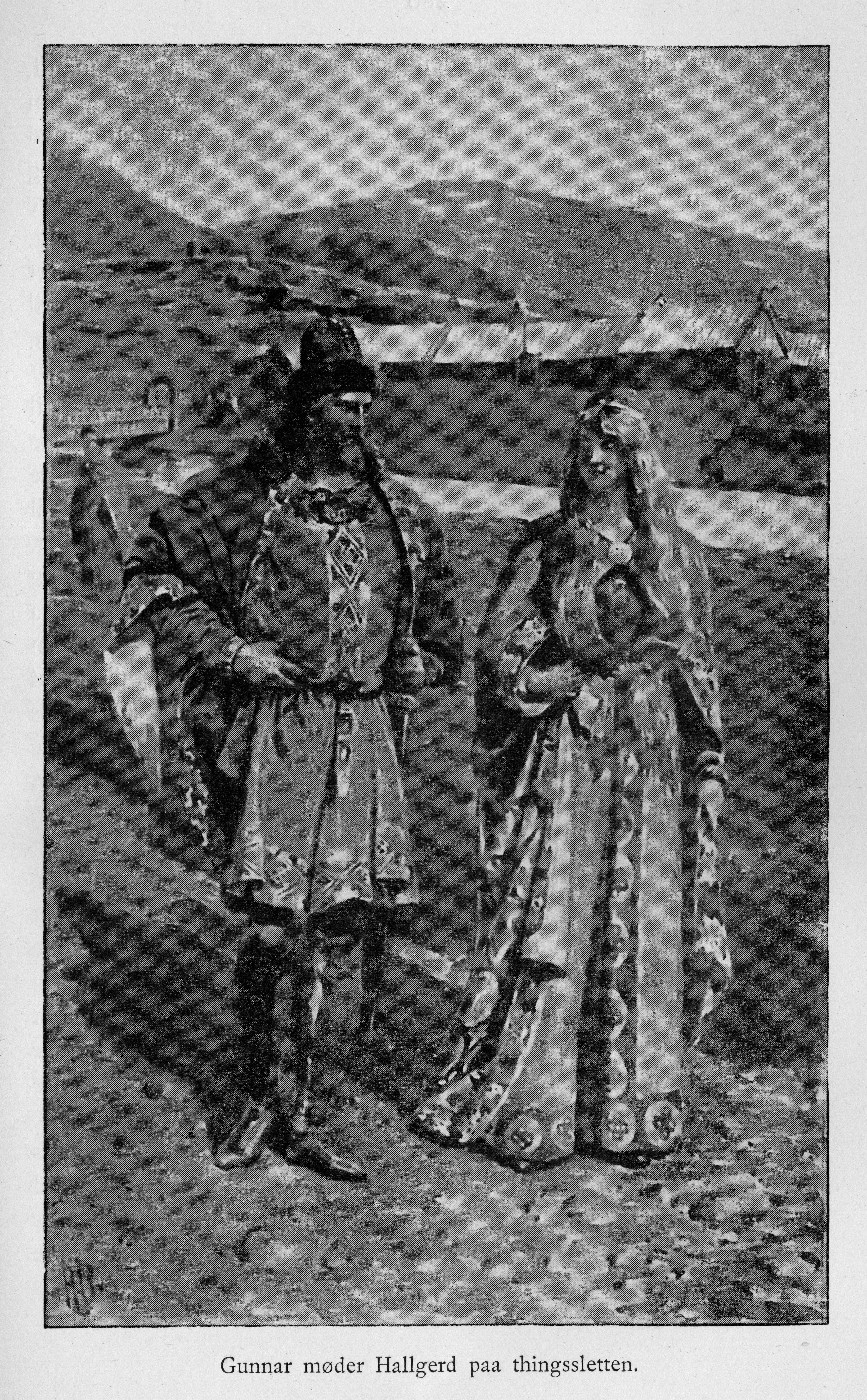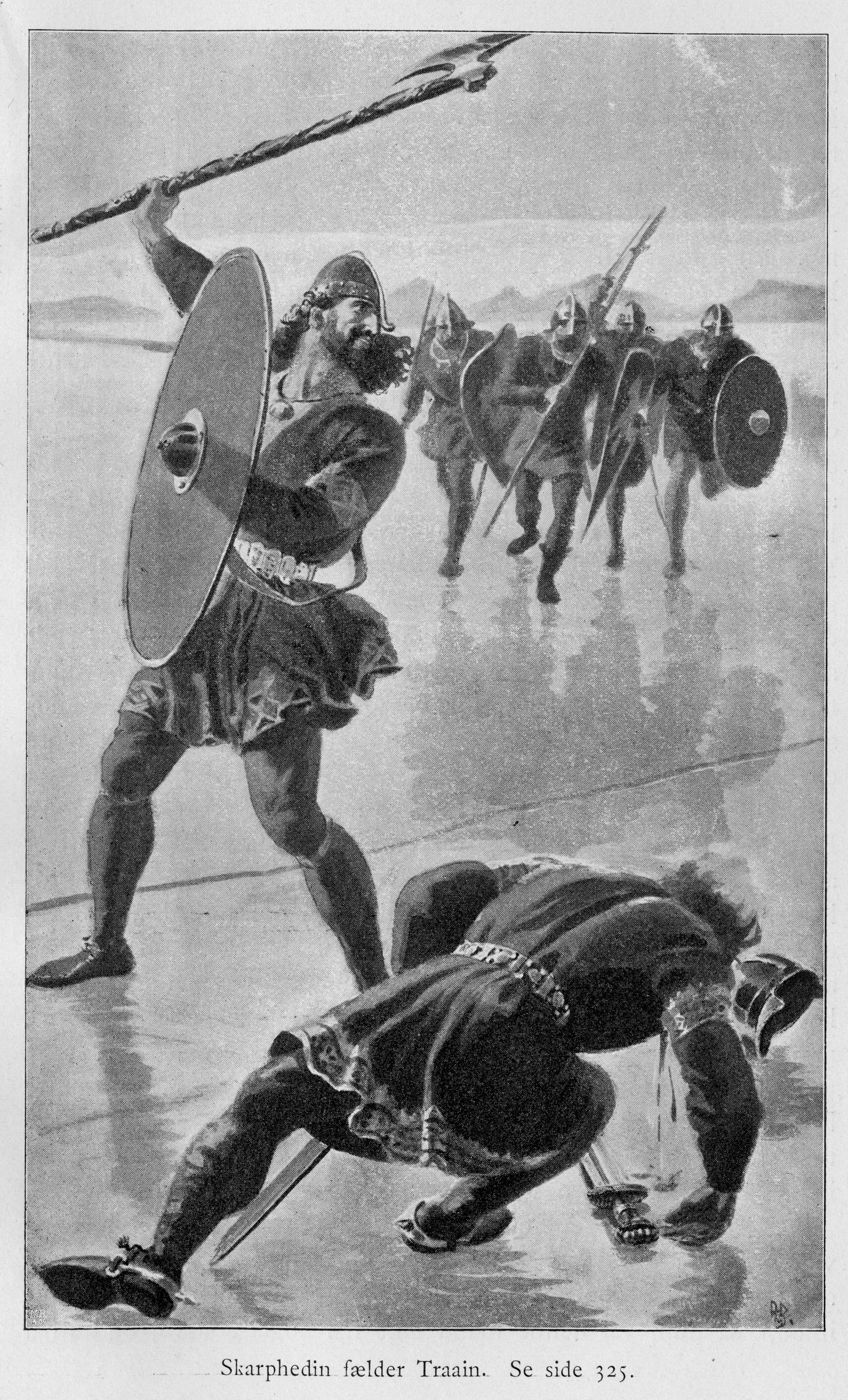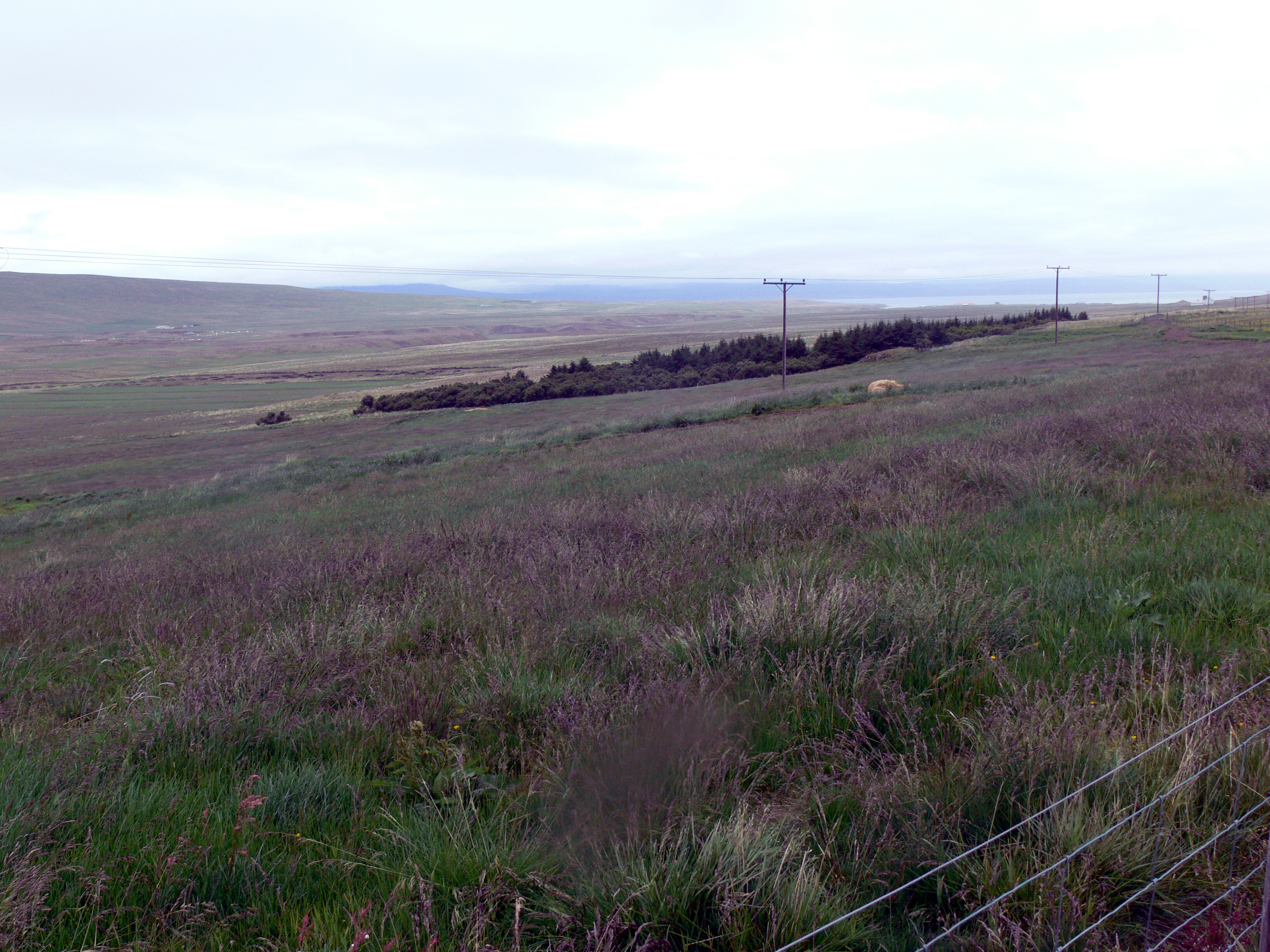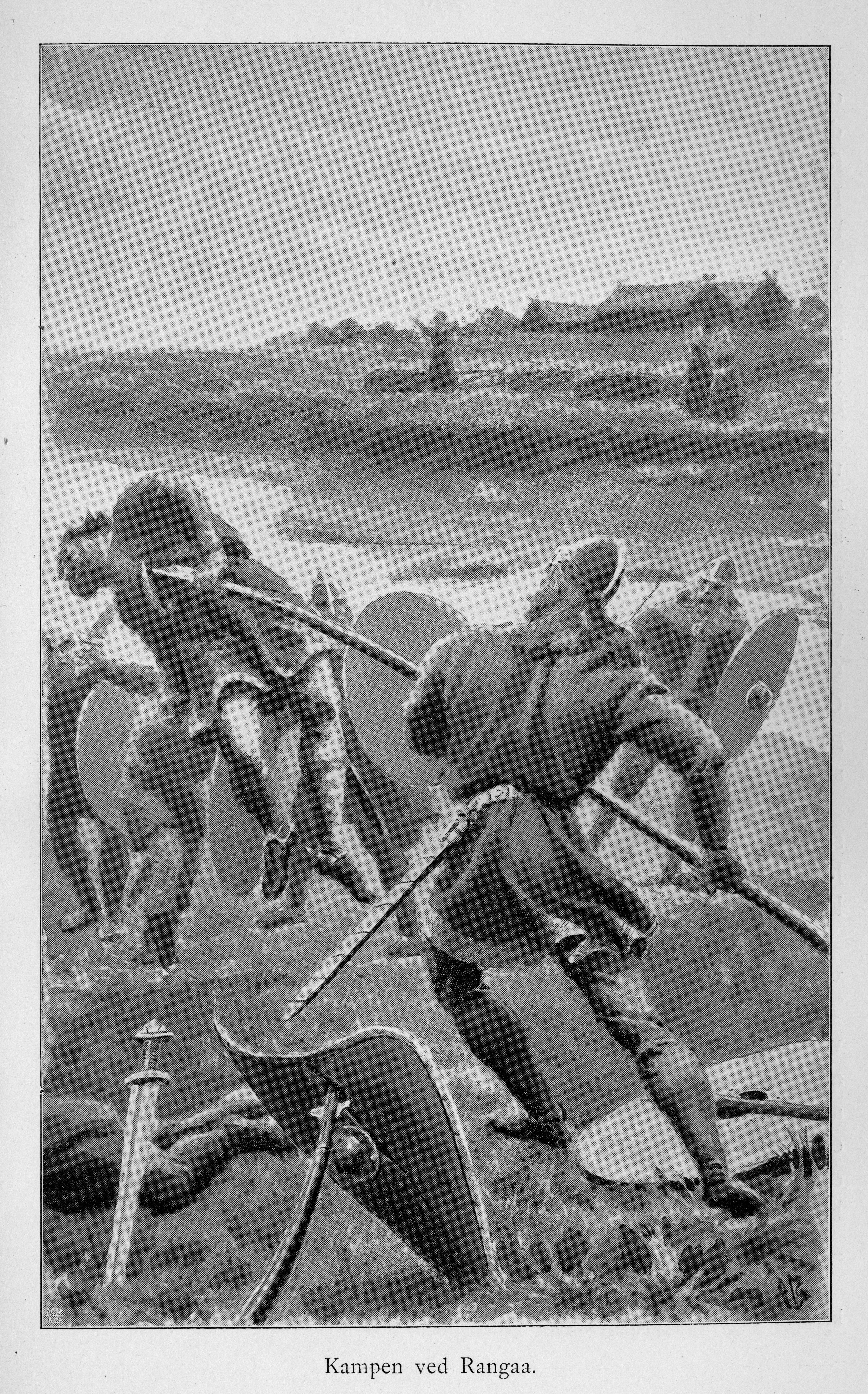|
Hallgerðr Höskuldsdóttir
Hallgerðr Höskuldsdóttir was a 10th-century Icelandic woman and is a major character in ''Njáls saga''. According to ''Landnámabók'', she was the daughter of Höskuld Dala-Kollson and the sister or half-sister of Þorleikr, Olaf the Peacock, Helgi, Þúriðr and Þorgerðr. Her nickname there is ''snúinbrók'' (‘twisted breeches’). In ''Njáls saga'' Hallgerðr is the daughter of Höskuld, living at Höskuldstaðir in Laxárdal. Her mother is absent from the narrative, but it is mentioned that she has a maternal uncle who is a sorcerer. When she is a child, her uncle Hrútr predicts that many will suffer because of her beauty and offends her father by saying that she has “thief’s eyes”. As an adult, she is described as beautiful, with hair “so long that it could veil her whole body.” She is tall, resulting in her nickname ''longbrók'' (‘long breeches’). Her personality is “impetuous and wilful.” She is said to have been negatively influenced b ... [...More Info...] [...Related Items...] OR: [Wikipedia] [Google] [Baidu] |
Njáls Saga
''Njáls saga'' ( ), also ''Njála'' ( ), or ''Brennu-Njáls saga'' ( ) (Which can be translated as ''The Story of Burnt Njáll'', or ''The Saga of Njáll the Burner''), is a thirteenth-century Icelandic saga that describes events between 960 and 1020. The saga deals with a process of blood feuds in the Icelandic Commonwealth, showing how the requirements of honor could lead to minor slights spiralling into destructive and prolonged bloodshed. Insults where a character's manhood is called into question are especially prominent and may reflect an author critical of an overly restrictive ideal of masculinity. Another characteristic of the narrative is the presence of omens and prophetic dreams. It is disputed whether this reflects a fatalistic outlook on the part of the author. The principal characters in the saga are the friends Njáll Þorgeirsson, a lawyer and a sage, and Gunnar Hámundarson, a formidable warrior. Gunnar's wife, Hallgerðr langbrók, instigates a feud that ... [...More Info...] [...Related Items...] OR: [Wikipedia] [Google] [Baidu] |
Landnámabók
(, "Book of Settlements"), often shortened to , is a medieval Icelandic written work which describes in considerable detail the settlement () of Iceland by the Norse in the 9th and 10th centuries CE. is divided into five parts and over 100 chapters. The first part tells of how the island was found. The latter parts count settlers quarter by quarter, beginning with west and ending with south. It traces important events and family history into the 12th century. More than 3,000 people and 1,400 settlements are described. It tells where each settler settled and provides a brief genealogy of his or her descendants. Sometimes short anecdote-like stories are also included. lists 435 people (', which includes men and women) as the initial settlers, the majority of them settling in the northern and southwestern parts of the island. It remains an invaluable source on both the history and genealogy of the Icelandic people. Some have suggested a single author, while others have ... [...More Info...] [...Related Items...] OR: [Wikipedia] [Google] [Baidu] |
Hoskuld Dala-Kollsson
Hoskuld Dala-Kollsson (Old Norse: ; Modern Icelandic: ; c. 910–965) was an Icelandic gothi or chieftain of the early Icelandic Commonwealth period. He was the son of Dala-Koll (Koll of the Dales) who has a fjörd named after him, and Thorgerd Thorsteinsdottir, daughter of Thorstein the Red. His father died when he was a child and his mother married a landowner named Herjolf, who became the father of Hoskuld's half-brother Hrútr Herjólfsson. Hoskuld was enormously influential in northwestern Iceland, particularly in the Laxardal region, and is one of the main characters of the first half of ''Laxdæla saga''. By his wife Jorunn he was the father of Bard, Thorleik, and Hallgerd and the grandfather of Bolli Thorleiksson. By his Irish concubine Melkorka he was the father of Olaf the Peacock and possibly of another son named Helgi. References *Ari the Learned. ''The Book of the Settlement of Iceland'' ''(Landnámabók (, "Book of Settlements"), often shortened to , ... [...More Info...] [...Related Items...] OR: [Wikipedia] [Google] [Baidu] |
Olaf The Peacock
Olaf the Peacock or Olaf Hoskuldsson (Old Norse: ; Modern Icelandic: ; c. 938–1006) was a merchant and chieftain of the early Icelandic Commonwealth, who was nicknamed "the Peacock" because of his proud bearing and magnificent wardrobe. He is a major character in the ''Laxdæla saga'' and is mentioned in a number of other Icelandic sources. The son of a slave woman, Olaf became one of the wealthiest landowners in Iceland and played a major role in its politics and society during the latter half of the tenth century. In addition to the ''Laxdæla Saga'' in which he takes a leading role, Olaf also is mentioned in ''Egils saga'', ''Njáls saga'', '' Gunnlaugs saga'', ''Kormáks saga'', '' Grettirs saga'' and the ''Landnámabók'', among others. Birth and upbringing Olaf was the son of Hoskuld Dala-Kollsson, a chieftain who lived in the Laxardal region. According to ''Laxdæla Saga'', Hoskuld purchased a mute thrall-woman named Melkorka from a Rus' merchant on Brännö while ... [...More Info...] [...Related Items...] OR: [Wikipedia] [Google] [Baidu] |
Laxárdalur
Laxárdalur () is a valley in Dalasýsla in northwestern Iceland, formed by the . It was the home of the , a group of Icelanders whose doings are described in the ''Laxdæla saga ''Laxdæla saga'' (), Old Norse ''Laxdœla saga'' (Old Norse pronunciation ) or ''The Saga of the People of Laxárdalur'', is one of the sagas of Icelanders. Written in the 13th century CE, it tells of people in the Breiðafjörður area in weste ...''. References {{Coord, 65, 09, N, 21, 35, W, region:IS_type:landmark, display=title Western Region (Iceland) Valleys of Iceland ... [...More Info...] [...Related Items...] OR: [Wikipedia] [Google] [Baidu] |
Gunnar Hámundarson
Gunnar Hámundarson () was a 10th-century Icelandic chieftain. He lived in Hlíðarendi in Fljótshlíð and is probably better known as Gunnar of Hlíðarendi (). He features prominently in the first half of Njáls saga, which tells of the chain of events ultimately leading to his death in battle. He was married to Hallgerðr Höskuldsdóttir of Höskuldsstaðir in Laxárdal in Dalasýsla, who was known as Hallgerðr langbrók ("Hallgerður longpants"). He was her third husband. It was said that she had killed both her former husbands, but she had in fact only killed the first. Their marriage was considered imprudent by Gunnar's friend Njáll Þorgeirsson, because it was caused by lust and not practicality. Gunnar the hero Gunnar was a god-like warrior — he is described as nearly invincible in combat. According to Njáls saga, he was a powerful, athletic man "capable of jumping his own height in full body armour, both back and front". He was a skilled archer, a ... [...More Info...] [...Related Items...] OR: [Wikipedia] [Google] [Baidu] |
Althing
The (; ), anglicised as Althingi or Althing, is the Parliamentary sovereignty, supreme Parliament, national parliament of Iceland. It is the oldest surviving parliament in the world. The Althing was founded in 930 at ('Thing (assembly), thing fields' or 'assembly fields'), about east of what later became the country's capital, Reykjavík. After Iceland's union with Norway in 1262, the Althing lost its legislative power, which was not restored until 1904 when Iceland gained home rule from Denmark. For 641 years, the Althing did not serve as the parliament of Iceland; ultimate power rested with the Norwegian, and subsequently the Danish throne. Even after Iceland's union with Norway in 1262, the Althing still held its sessions at until 1800, when it was discontinued. It was restored in 1844 by royal decree and moved to Reykjavík. The restored Unicameralism, unicameral legislature first came together in 1845 and after 1874 operated in Bicameralism, two chambers with an addition ... [...More Info...] [...Related Items...] OR: [Wikipedia] [Google] [Baidu] |
Njáll Þorgeirsson
Njáll Þorgeirsson (Old Norse: ; Modern Icelandic: ) was a 10th and early-11th-century Icelandic lawyer who lived at Bergþórshvoll in Landeyjar, Iceland. He was one of the main protagonists of ''Njáls saga'', a medieval Icelandic saga which describes a series of blood feuds. Biography Njáll was the son of Þorgeir gollnir Ófeigsson. His paternal grandfather had fallen out of favour with the king and therefore decided to leave Norway but as he had prepared and was about to leave when the king's errandmen came to him and took his life. After that his grandmother and their children and her brother left for Iceland. ''Njáls saga'' does not in important events contradict other sources but in details such as genealogy it sometimes contradicts the ''Landnámabók (, "Book of Settlements"), often shortened to , is a medieval Icelandic written work which describes in considerable detail the settlement () of Iceland by the Norse in the 9th and 10th centuries CE. is ... [...More Info...] [...Related Items...] OR: [Wikipedia] [Google] [Baidu] |
Bergþóra Skarphéðinsdóttir
Bergþóra Skarphéðinsdóttir (anglicised as Bergthora Skarphedinsdottir) was a 10th-century Icelandic woman who appears as a character in ''Njáls saga'' as an inciter of its main feud. ''Njáls saga'' Bergþóra is introduced in the saga as 'an exceptional and courageous woman, but a little harsh-natured.' She is the daughter of Skarp-Heðinn, and married to the lawspeaker Njáll Þorgeirsson. They have three sons: Skarphéðinn Njálsson, Skarp-Heðinn, Grímr, and Helgi. Njal also has an illegitimate son, Höskuldr Njálsson, with his concubine, Hróðný. Hróðný has a long-term relationship with Njal and views Bergþóra as her rival. The family lives at Bergþórshvoll, Bergþórsvoll. At an autumn feast hosted by Njáll and Bergþóra, Bergþóra enters into a quarrel with Hallgerðr Höskuldsdóttir, Hallgerðr Höskuldsdottir, the wife of Njáll's friend Gunnar Hámundarson. Despite Gunnar's and Njal's efforts to peacefully settle the disagreement, Hallgerðr and B ... [...More Info...] [...Related Items...] OR: [Wikipedia] [Google] [Baidu] |
Lisa Hammond (actress)
Lisa Jayne Hammond (born 3 June 1978) is an English actress, known for her roles as Donna Yates in ''EastEnders'' and as Tina in ''Max and Paddy's Road to Nowhere''. In 2005, she had a minor role in the BBC adaptation of Charles Dickens' ''Bleak House''. In 2009, she appeared in the first series of '' Psychoville''. Career She played the character Denny in ''Grange Hill'' between 1994 and 1996. Hammond did not star in any major roles again until 2004 when she played Tina in ''Max and Paddy's Road to Nowhere''. However, she had minor appearances in television programmes such as ''Holby City'', '' Where the Heart Is'' and ''Casualty'', and in the film '' Quills''. Hammond also played the major role of the herald in the Royal Shakespeare Company revival of ''Marat/Sade'' in 2011. In 2004 she co-starred with Mat Fraser in the TV movie ''Every time you look at me'' In 2005, she played Harriet in the BBC TV mini series, ''Bleak House'', whilst in 2009 and 2011 Hammond played Kerr ... [...More Info...] [...Related Items...] OR: [Wikipedia] [Google] [Baidu] |
BBC Radio 3
BBC Radio 3 is a British national radio station owned and operated by the BBC. It replaced the BBC Third Programme in 1967 and broadcasts classical music and opera, with jazz, world music, Radio drama, drama, High culture, culture and the arts also featuring. The station has described itself as "the world's most significant commissioner of new music". Through its BBC Radio 3 New Generation Artists scheme, New Generation Artists scheme, it promotes young musicians of all nationalities. The station broadcasts the The Proms, BBC Proms concerts, live and in full, each summer in addition to performances by the BBC Orchestras and Singers. There are regular productions of both classic plays and newly commissioned drama. Radio 3 won the Sony Radio Academy UK Station of the Year Gold Award for 2009 and was nominated again in 2011. According to RAJAR, the station broadcasts to a weekly audience of 1.9 million with a listening share of 1.6% as of March 2024. History Radio 3 is the ... [...More Info...] [...Related Items...] OR: [Wikipedia] [Google] [Baidu] |





